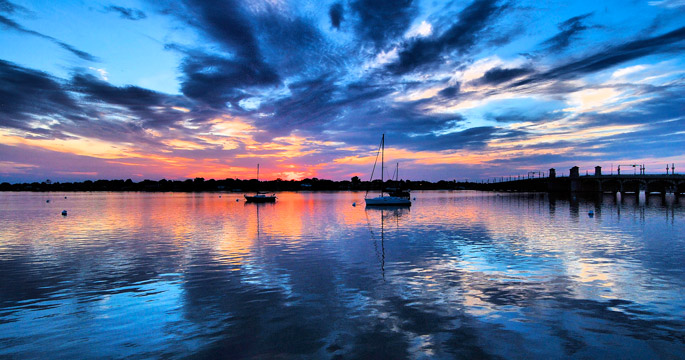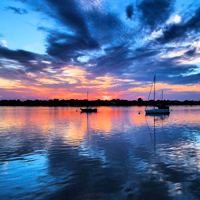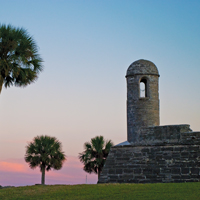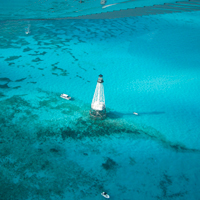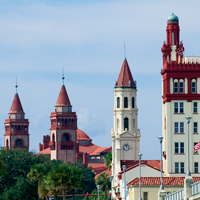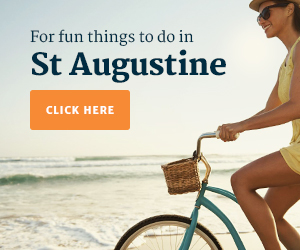If someone told you St. Augustine is a town for history buffs, they’re right-and wrong. Northeast Florida’s gem is way more than timeworn forts and buildings (even though it has those and they’re pretty amazing). It’s a city of old-world elegance, exquisite architecture and brick- lined streets you can travel by horse-drawn carriage or explore on foot. And when you tire of that there’s a golden-sand beach and stretches of wilderness just a short drive away.
1 History, History, History
This is Florida’s birthplace where Spanish explorer Juan Ponce de Leon came ashore in 1513 and named the land Florida or “place of flowers.” Since his claim, the French, British and Spanish all took turns at establishing settlements here. Well preserved, St. Augustine is a history lesson on Florida.
2 Architecture Flashback
Not only the Europeans left their mark on the town with Spanish colonial structures like the Oldest House built in the early 1700s. Visionary Henry Flagler came along in the late 1800s and built gorgeous churches with byzantine detailing and luxury hotels in the Spanish Renaissance Revival style that put Florida’s tourism industry in motion. The city’s centerpiece is the Ponce de Leon Hotel, now Flagler College, which still stands in full splendor along with Flagler’s other hotels.
3 Bed-and-Breakfast Bliss
This is the land of bed-and-breakfasts, and one B&B is more inviting than the next. Nestled in the side streets and across from the Intracoastal Waterway, these homes, most built in the early 1900s, are designed and decorated to celebrate a bygone era. Expect the ultimate: lots of lace, four poster beds, bric-a-brac touches, that quintessential wraparound porch and an elegant breakfast.
4 Made for Walking
Park your car and forget it. This a town designed for those who want to stroll, meander and just plain walk. The compact historic district’s brick-lined streets are jammed with shops, cafes and historic buildings. Sitting on the edge of Matanzas Bay, St. Augustine enjoys cool breezes off the water in summer when temperatures soar to the 90s. In winter months, highs in the 60s provide perfect walking weather.
5 Sights to See
Map in hand, you can navigate the streets on foot or board the Old Town Trolley and hop off and on as you please. There’s no shortage of historic sites, with the Castillo de San Marcos, a fort on the bay built from coquina, being a crowd pleaser. Reenactments add fun to a visit. Or stop at the Fountain of Youth, an archeological park that documents the area’s past. For a twist on traditional history take a tour of the Old Jail, where stories of past criminals portray the town’s darker side. And for those who want a paranormal experience, there’s always the ghost tours through haunted back alleys and old buildings.
6 A Romp with Nature
Spend an afternoon outdoors at Anastasia State Park, a short drive across St. Augustine’s landmark Bridge of Lions. From wooden boardwalks that cross sand dunes spiked with sea oats, you’ll get a view of the mighty Atlantic Ocean. At the park’s Salt Run, windsurfers, paddleboarders and brown pelicans show off their skills. You can also head north from the city to Guana River State Park, a stretch of Old Florida wilderness on the edge of the ocean, where you’ll have the beach pretty much to yourself.
7 Surf’s Up
Whether you want to hang five or just frolic in the waves, nearby St. Augustine Beach has that old-fashioned beach-bum vibe. No sleek high-rises will steal your sun, so spread a blanket and soak up the rays. It’s also a favorite stretch with fishermen, who reel in dinner from the municipal fishing pier, and bicyclists, who rent beach cruisers and pedal along Highway A1A, stopping for cold drinks, ice cream and seafood at the beach bars along the route.
8 Shopping Spree
A treasure trove, historic St. Augustine is chock-full of shops tucked in every nook and cranny. At the stores on St. George Street and its arteries, you’ll find whimsical gifts, handmade chocolates, exotic spices, hand-rolled cigars and more. Vintage-centric merchandise is plentiful in the antiques and collectible shops on San Marco Avenue, where shipwreck artifacts, estate jewelry and antique furniture are on display in Victorian homes-turned-shops.
9 Whoa Boy
The clip-clop of horses’ hooves as they pull vintage carriages through St. Augustine’s brick streets is heard from sunrise to nightfall. Almost impossible to resist the romantic tug of riding in one of yesteryear’s horse-drawn carriages, most visitors sooner or later give in to the urge and take a whirlwind tour of the historic district. Drivers eagerly share their animated version of the city’s past with passengers.
10 Holiday Spectacle
During Nights of Lights (mid-November to end of January) the city is adorned with 3 million tiny lights, and you couldn’t choose a more festive time to visit. At events like the Bed and Breakfast Holiday Tour, innkeepers open their doors to show off their homes decked with garland and Victorian Christmas trees. The Holly Jolly Trolley, a Yuletide-version of the Old Town Trolley tour, travels past the city’s most extravagant light displays. But the best part: Passengers view the spectacle like never before through 3-D glasses.

